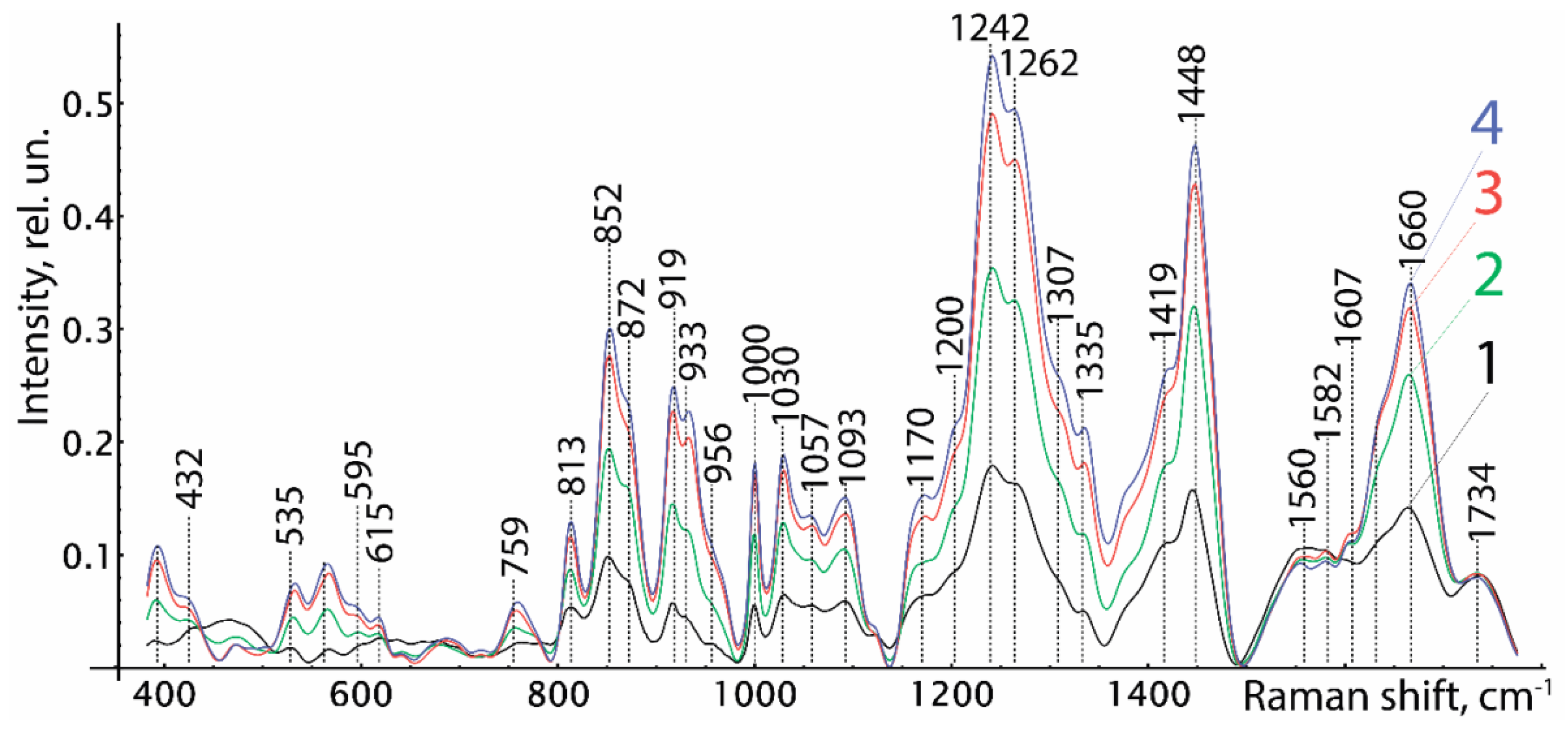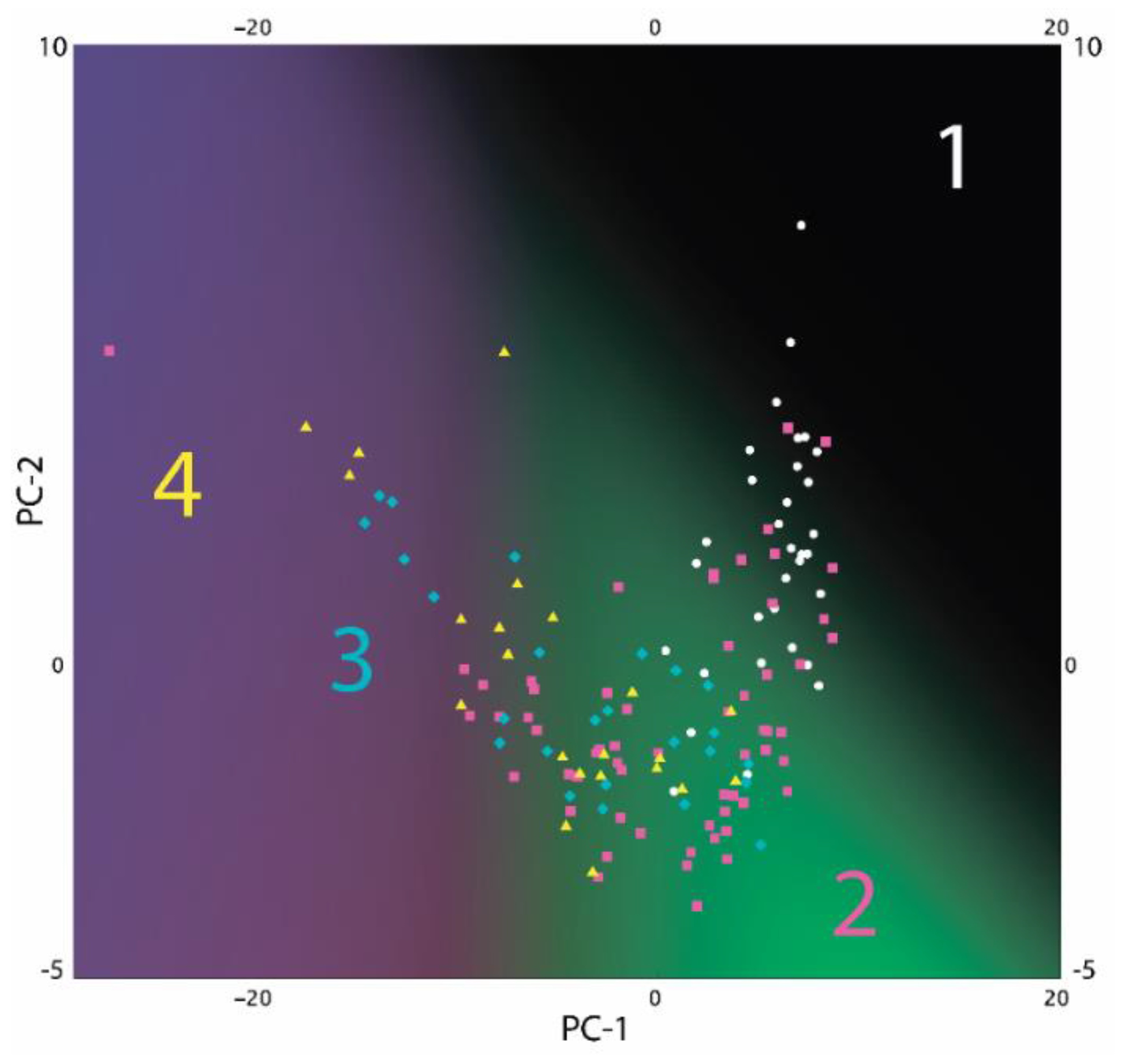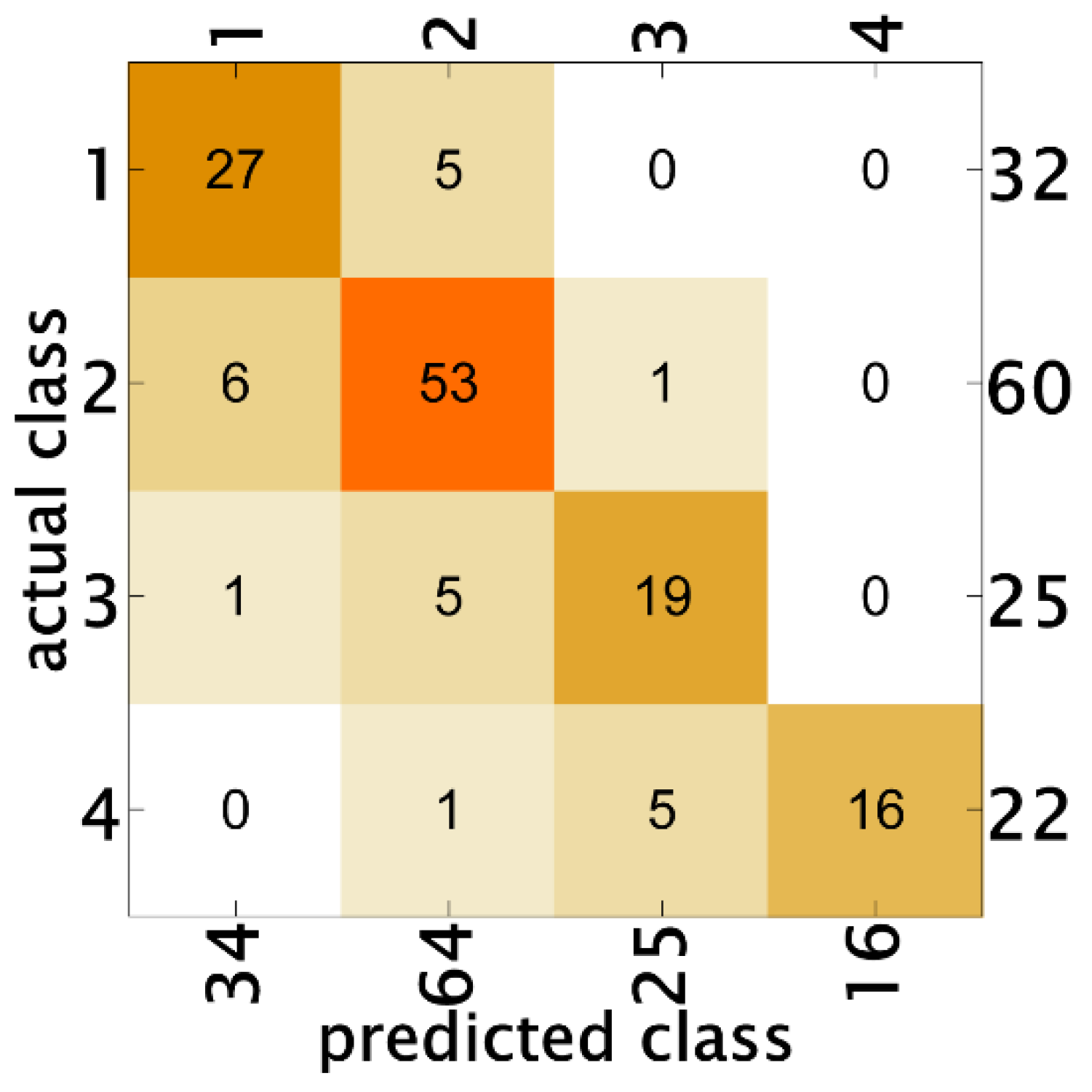Comparative Characteristics of Biomaterials from Juvenile Dentin and Brefomatrix Using Raman Spectroscopy
Abstract
:1. Introduction
2. Materials and Methods
3. Results
4. Discussion
5. Conclusions
Author Contributions
Funding
Data Availability Statement
Acknowledgments
Conflicts of Interest
References
- Kirilova, I.A.; Sadovoy, M.A.; Podorozhnaja, V.T. Comparative characteristics of materials for bone grafting: Composition and properties. Novosib. Res. Inst. Traumatol. Orthop. Dig. 2012, 3, 72–83. [Google Scholar] [CrossRef]
- Smbatjan, B.S. Regeneration of Bone Tissues during Treating the Patients Using Dental Implants in Different Clinical Situations. Ph.D. Thesis, Moscow State University of Medicine and Dentistry, Moscow, Russia, 2012. [Google Scholar]
- Manazza, F.; La Rocca, S.; Nagni, M.; Chirico, L.; Cattoni, F. A simplified digital workflow for the prosthetic finishing of implant rehabilitations: A case report. J. Biol. Regul. Homeost. Agents 2021, 35, 87–97. [Google Scholar] [CrossRef] [PubMed]
- Tetè, G.; D’orto, B.; Ferrante, L.; Polizzi, E.; Cattoni, F. Role of mast cells in oral inflammation. J. Biol. Regul. Homeost. Agents 2021, 35, 65–70. [Google Scholar] [CrossRef]
- Trukhanova, Y.R. The Use of Osteoplastic Material «Bioimplant» for Comprehensive Treatment of Periodontal Disease. Ph.D. Thesis, Moscow State University of Medicine and Dentistry, Moscow, Russia, 2005. [Google Scholar]
- Xiaoru, F.; Luyuan, J.; Ping, M.; Zhipeng, F.; Songlin, W. Allogeneic Stem Cells From Deciduous Teeth in Treatment for Periodontitis in Miniature Swine. J. Periodontol. 2014, 85, 845–851. [Google Scholar] [CrossRef]
- Satoru, O.; Takanori, I. Application of Periodontal Ligament-Derived Multipotent Mesenchymal Stromal Cell Sheets for Periodontal Regeneration. Int. J. Mol. Sci. 2019, 20, 2796. [Google Scholar] [CrossRef]
- Shcheblykina, A.V.; Mishchenko, P.V.; Kumeiko, V.V. Pectin-based biocompatible degradable materials for tissue engineering. Pac. Med. J. 2013, 2, 13–17. [Google Scholar]
- Tansik, G.; Kilic, E.; Beter, M.; Demiralp, B.; Sendur, G.K.; Can, N.; Ozkan, H.; Ergul, E.; Guler, M.O.; Tekinay, A.B. A glycosaminoglycan mimetic peptide nanofiber gel as an osteoinductive scaffold. Biomater. Sci. 2016, 4, 1328–1339. [Google Scholar] [CrossRef]
- Kirichenko, V.N.; Marchenko, N.V. Experimental substantination of biological and synthetic osteoplastic materials use at surgical treatment of general periodontitis. Crime. J. Intern. Dis. 2012, 2, 106–108. [Google Scholar]
- Volova, L.T.; Samsonov, V.Е. The use of demineralized bone brefomatrix for plasty of different post-operative defects of the jaw. Stomatologiya [Dentistry] 1993, 73, 35–37. [Google Scholar]
- Bazhutova, I.V. Comparative Analysis of the Use of Osteoplastic Materials for Surgical Treatment of Periodontal Disease. Ph.D. Thesis, Federal State University “Central Research Institute of Dentistry”, Moscow, Russia, 2006. [Google Scholar]
- Butlerand, W.; Ritchie, H. The nature and functional significance of dentin extracellular matrix proteins. Int. J. Dev. Biol. 1995, 39, 169–179. [Google Scholar]
- Misch, C.E.; Dietsh, F. Bone-grafting materials in implant dentistry. Implant Dent. 1993, 2, 158–167. [Google Scholar] [CrossRef] [PubMed]
- Devecioglu, D.; Tözüm, T.F.; Sengün, D.; Nohutcu, R.M. Biomaterials in periodontal regenerative surgery: Effects of cryopreserved bone, commercially available coral, demineralized freeze-dried dentin, and cementum on periodontal ligament fibroblasts and osteoblasts. J. Biomater. Appl. 2004, 19, 107–120. [Google Scholar] [CrossRef]
- Kim, Y.K.; Kim, S.G.; Byeon, J.H.; Lee, H.J.; Um, I.U.; Lim, S.C.; Kim, S.Y. Development of a novel bone grafting material using autogenous teeth. Oral Surg. Oral Med. Oral Pathol. Oral Radiol. Endod. 2010, 109, 496–503. [Google Scholar] [CrossRef]
- Murata, M.; Akazawa, T.; Mitsugi, M.; Um, I.W.; Kim, K.W.; Kim, Y.K. Human Dentin as Novel Biomaterial for Bone Regeneration. Biomater.-Phys. Chem. 2011, 6, 127–140. [Google Scholar]
- Privalov, V.Е.; Shemanin, V.G. Optimization of differential absorption and scattering lidar for sensing molecular hydrogen in the atmosphere. Technol. Phys. 1999, 69, 65–70. [Google Scholar] [CrossRef]
- Sukhinina, A.V. The Method Sofoptical Spectros Copy for Dental Disease Diagnosis. Ph.D. Thesis, National Research Nuclear University MEPh, Moscow, Russia, 2014. [Google Scholar]
- Almahdy, A.; Downey, F.C.; Sauro, S.; Cook, R.J.; Sherriff, M.; Richards, D.; Watson, T.F.; Banerjee, A.; Festy, F. Microbiochemical analysis of carious dentine using raman and fluorescence spectroscopy. Caries Res. 2012, 46, 432–440. [Google Scholar] [CrossRef] [PubMed]
- Gonchukov, S.; Sukhinina, A.; Bakhmutov, D.; Minaeva, S. Raman spectroscopy of saliva as a perspective method for periodontitis diagnostics. Laser Phys. Lett. 2012, 9, 73–77. [Google Scholar] [CrossRef]
- Mandra, Y.V.; Ivashov, A.S.; Votjakov, S.L.; Kiseleva, D.V. Possibilities of Raman microspectrometry imaging for structural investigation of human enamel and dentin. Eksperimentalnaya Klin. Stomatol. 2011, 1, 24–28. [Google Scholar]
- Timchenko, E.V.; Timchenko, P.E.; Volova, L.T.; Frolov, O.O.; Zibin, M.; Bazhutova, I.V. Raman spectroscopy of changes in the tissues of teeth with periodontitis. Diagnostics 2020, 10, 876. [Google Scholar] [CrossRef] [PubMed]
- Ionita, I. Diagnosis of tooth decay using polarized micro-Raman confocal spectroscopy. Rom. Rep. Phys. 2009, 61, 567–574. [Google Scholar]
- Raghavan, M. Investigation of Mineral and Collagen Organization in Bone Using Raman Spectroscopy. Ph.D. Thesis, University of Michigan, Ann Arbor, MI, USA, 2011. [Google Scholar]
- Timchenko, E.V.; Timchenko, P.E.; Pisareva, E.V.; Vlasov, M.Y.; Volova, L.T.; Frolov, O.O.; Fedorova, Y.V.; Tikhomirova, G.P.; Romanova, D.A.; Daniel, M.A. Spectral Analysis of Rat Bone Tissue During Long Antiorthostostatic Hanging and at Introduction of Allogen Hydroxyapatitis. Opt. Spectrosc. 2020, 128, 989–997. [Google Scholar] [CrossRef]
- Timchenko, E.V.; Timchenko, P.E.; Pisareva, E.V.; Daniel, M.A.; Volova, L.T.; Fedotov, A.A.; Frolov, O.O.; Subatovich, A.N. Optical analysis of bone tissue by Raman spectroscopy in experimental osteoporosis and its correction using allogeneic hydroxyapatite. J. Opt. Technol. 2020, 87, 161–167. [Google Scholar] [CrossRef]
- Timchenko, P.E.; Timchenko, E.V.; Volova, L.T.; Zybin, M.A.; Frolov, O.O.; Dolgushov, G.G. Optical Assessment of Dentin Materials. Opt. Mem. Neural Netw. 2020, 29, 354–357. [Google Scholar] [CrossRef]
- Udaltsova, K.А. The structure of intact dentin and enamel of human juvenile teeth Mir meditsini I biologii. World Med. Biol. 2008, 4, 70–76. [Google Scholar]
- Movasaghi, Z.; Rehman, S.; Rehman, I. Raman Spectroscopy of Biological Tissues. Appl. Spectrosc. Rev. 2007, 42, 493–541. [Google Scholar] [CrossRef]
- Sukhodub, L.; Moseke, C.; Sulkio-Cleff, B.; Maleev, V.Y.; Semenov, M. Collagen–hydroxyapatite–water interactions investigated by XRD, piezogravimetry, infrared and Raman spectroscopy. J. Mol. Struct. 2004, 704, 53–58. [Google Scholar] [CrossRef]
- Ramakrishnaiah, R.; Rehman, G.; Basavarajappa, S.; Khuraif, A.; Durgesh, B.; Khan, A.; Rehman, I. Applications of Raman spectroscopy in dentistry: Analysis of tooth structure. Appl. Spectrosc. Rev. 2015, 50, 332–350. [Google Scholar] [CrossRef]



Publisher’s Note: MDPI stays neutral with regard to jurisdictional claims in published maps and institutional affiliations. |
© 2022 by the authors. Licensee MDPI, Basel, Switzerland. This article is an open access article distributed under the terms and conditions of the Creative Commons Attribution (CC BY) license (https://creativecommons.org/licenses/by/4.0/).
Share and Cite
Timchenko, E.V.; Bazhutova, I.V.; Timchenko, P.Е.; Frolov, O.О.; Volova, L.Т. Comparative Characteristics of Biomaterials from Juvenile Dentin and Brefomatrix Using Raman Spectroscopy. Biophysica 2022, 2, 308-314. https://doi.org/10.3390/biophysica2040028
Timchenko EV, Bazhutova IV, Timchenko PЕ, Frolov OО, Volova LТ. Comparative Characteristics of Biomaterials from Juvenile Dentin and Brefomatrix Using Raman Spectroscopy. Biophysica. 2022; 2(4):308-314. https://doi.org/10.3390/biophysica2040028
Chicago/Turabian StyleTimchenko, Elena V., Irina V. Bazhutova, Pavel Е. Timchenko, Oleg О. Frolov, and Larisa Т. Volova. 2022. "Comparative Characteristics of Biomaterials from Juvenile Dentin and Brefomatrix Using Raman Spectroscopy" Biophysica 2, no. 4: 308-314. https://doi.org/10.3390/biophysica2040028
APA StyleTimchenko, E. V., Bazhutova, I. V., Timchenko, P. Е., Frolov, O. О., & Volova, L. Т. (2022). Comparative Characteristics of Biomaterials from Juvenile Dentin and Brefomatrix Using Raman Spectroscopy. Biophysica, 2(4), 308-314. https://doi.org/10.3390/biophysica2040028





